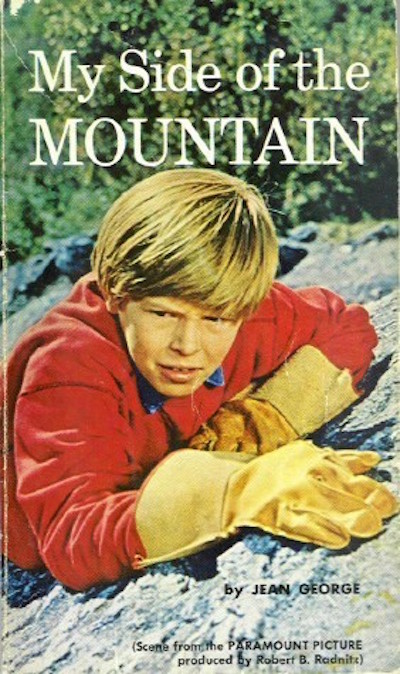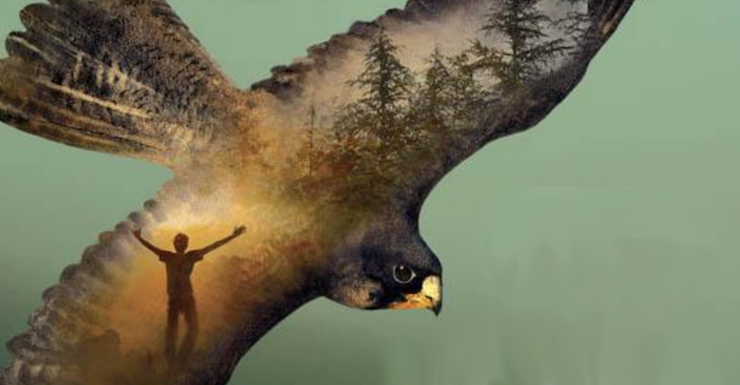For the past two years, I’ve been obsessed with the YouTube channel Primitive Technology. I’m not alone. Each video racks up millions of hits within hours of release.
These videos have no plot, no dialogue, no conflict, and no real narrative. Despite this, they’re compelling in a very literary sense. They remind me of my favorite book in fourth grade, Jean Craighead George’s My Side of the Mountain. And they embody many of the the qualities I’ve tried to channel into my own book series, Arlo Finch.
The premise of Primitive Technology couldn’t be simpler: an Unnamed White Guy wearing only blue cargo shorts stomps around in a semi-tropical forest, building things.
He doesn’t talk, and doesn’t use any tools other than what he finds or makes. If he needs an axe, he chips away at a rock to create a blade, then lashes it to a handle. If he needs a fire, he builds one on the spot, using just a stick and his bare hands. (And feet. A recurring motif of these videos is just how useful one’s feet can be.)
It’s never quite clear how much time is passing— days? weeks?—but as you watch you see Unnamed White Guy build tile-roof cabins, various traps, weapons, kilns, and even a blast furnace for smelting metal.
What is it that makes these videos so compelling?
It’s not the music or the narration or the humor—these are all absent. Rather, I think the secret sauce of Primitive Technology is the combination of three key elements:
Survival. We see a man tackling the most basic of Maslow’s hierarchy of needs: food and shelter. From Gravity to The Walking Dead, we’re drawn to stories with primal stakes. We want to imagine ourselves in those situations. Could we survive by just our wits? Stripped of all of modern life’s conveniences, we would be unburdened by its pressures to conform and cooperate.
Agency. Unlike Robinson Crusoe or Tom Hanks’s character in Cast Away, Unnamed White Guy is choosing to be in the woods. He’s not trapped or marooned; he could leave at any time. Like Thoreau in Walden or Cheryl Strayed in Wild, he is isolating himself in order to learn and grow. These characters are climbing higher on Maslow’s pyramid to achieve self-esteem and self-actualization. I suspect many of us crave becoming better versions of ourselves but feel caught up in the quotidian demands of modern life.
Process. If these videos merely revealed the things Unnamed White Guy had made, no one would watch them. Instead, they show the struggle, the work and the competence. Like Andy Weir’s The Martian, the story is less about what he does than how he does it. We love to see transformation and the rewards of mastery. Unnamed White Guy doesn’t just a make a fire once. He does it nearly every video, and each time it seems like magic.
To me, it’s the combination of these three elements— Survival, Agency and Process— that make Primitive Technology so compelling.
But Unnamed White Guy hasn’t really discovered anything new. Rather, just like the stone axes he fashions, he’s taken a formula that’s existed for millennia and carried it to a new medium.
When I was ten years old, my Primitive Technology was a paperback copy of My Side of the Mountain.
I’d bought it at a Scholastic Book Fair. This edition was a movie tie-in, with a cover photo showing a sour-faced blond kid clinging to a rock. A quick Google Image search reveals it is by far the worst of all the covers. The others invariably depict the hero’s falcon, along with a silver Newbery Award sticker. These covers communicate ambition and adventure.
My paperback’s cover is conveying, Ew! That Smells!

Beyond the cover, however, the book is fantastic.
The novel tells the story of 15-year-old Sam Gribley, who runs away from his family’s crowded New York City apartment to live in the woods on an abandoned farm in the Catskills. Knowing almost nothing about survival, Sam reads up in the local library, and quickly fashions a shelter for himself in the burned-out hollow of an old tree. Over the course of a year, he teaches himself how to hunt, tan leather, and train his peregrine falcon, Frightful.
Eventually, there’s a reconciliation with his family, but that’s not the focus of the story. Rather, it’s about coming to terms with one’s self.
My Side of the Mountain was a revelation to me. Most of the books I’d been reading were either mystery series like The Three Investigators or fantasy like The Chronicles of Narnia. My Side of the Mountain was escapist realism. There were no magic portals or talking lions. Everything Sam Gribley was encountering existed in the real world.
The only difference between Sam and me was our situation. And courage.
I’d long fantasized about running away. It wasn’t to escape anything in particular— my childhood in Colorado was damn near idyllic— but simply for the rush of independence. As kids, we’re torn between wanting to be free and wanting to be safe. Sam Gribley had made his choice. He chose freedom.
I envied him. His life of falcons, venison and acorn pancakes seemed vastly more fulfilling than my school and Scouts. I never reread the book, but I never forgot it either. Like much of the best kids’ lit, I internalized it. It became part of my backstory, even if it was really just words on a page.
For the past twenty years, I’ve made my living putting words on a page. As a screenwriter, most of my movies tell stories of heroes who travel through a fantasy world, be it a mythic American South (Big Fish) or an Oompa Loompa sweatshop (Charlie and the Chocolate Factory).
Two years ago, when I started writing Arlo Finch in the Valley of Fire, I knew my titular hero would be crossing into the Long Woods, a fantastical forest filled with bizarre creatures and otherworldly dangers. But I was just as determined to have my hero explore the real forest outside his town. These were different mountains, but there was going to be a lot of My Side in my book.
Arlo Finch and Sam Gribley are learning many of the same skills. They build shelters and fires. They distinguish between various types of animal dung. They confront the elements and their own self-doubt.
And like Sam Gribley, Arlo Finch is actively choosing to do all this. He has agency. In many middle-grade fantasy titles, heroes have their destiny laid out for them. They are the savior, the Chosen One. While these heroes might initially deny their Joseph Campbell-ian call to adventure, there’s never any doubt which path they’ll ultimately take.
For Arlo Finch, I wanted to give him plenty of opportunities to bail. He could just say no, the same way Sam could go home, or reveal his true identity to the adults in town. Arlo Finch is not responsible for saving anyone—until he ultimately makes the choice to intercede.
And because prose fiction allows us to look inside a character’s head, Arlo’s thought process is made visible. We see him grapple with decisions, and wrestle with how to apply the principles he’s learning in his Ranger Field Book to the real situations he’s facing.
Writing Arlo Finch in the Valley of Fire—and its sequels—has been a form of time travel. Each day I sit down at my keyboard and step back into my younger brain, remembering what I wanted and what I feared.
Like Unnamed White Guy, I show up with nothing. Before I can do anything, I have the fashion the tools—the characters and situations—that allow me to build the world I need.
And like Unnamed White Guy, I decided to document the process.
In addition to Arlo Finch, I created a six-episode podcast series called Launch. It charts how the book came to be, from initial idea to bookstore shelves. It’s a look behind the curtain and inside my head.
Ultimately, I owe Jean Craighead George’s My Side of the Mountain a huge debt not just for inspiring me to write this book, but for inspiring me to become a writer at all. The choice to make one’s living as a writer is a lot like running away into the woods. It’s risky. You’re likely to face hardship. Your family will keep trying to get you to come home.
But if you persevere—if you make it through the winter—the experience is unlike any other.
 John August is a screenwriter whose credits include Big Fish, Charlie’s Angels, Charlie and the Chocolate Factory, Corpse Bride, and Frankenweenie. He is also the creator of the Writer Emergency Pack, an educational storytelling school distributed to more than two thousand classrooms worldwide. His new book, Arlo Finch in the Valley of Fire, is the first installment in a spellbinding fantasy adventure series. Born and raised in Boulder, Colorado, John now lives in Los Angeles with his family.
John August is a screenwriter whose credits include Big Fish, Charlie’s Angels, Charlie and the Chocolate Factory, Corpse Bride, and Frankenweenie. He is also the creator of the Writer Emergency Pack, an educational storytelling school distributed to more than two thousand classrooms worldwide. His new book, Arlo Finch in the Valley of Fire, is the first installment in a spellbinding fantasy adventure series. Born and raised in Boulder, Colorado, John now lives in Los Angeles with his family.










